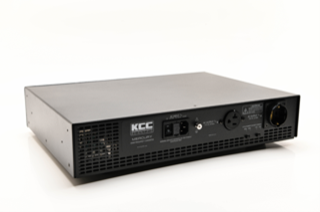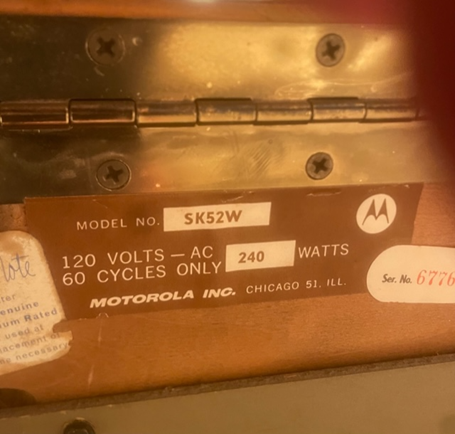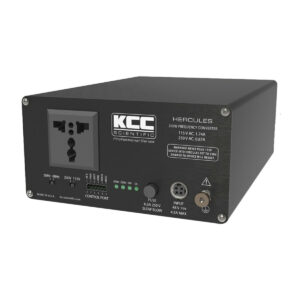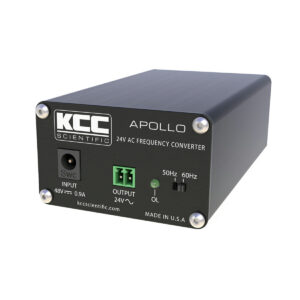
Power Conversion and Conditioning for Audio
KCC Converters power precision audio equipment across the globe up to 1000 watts. KCC Scientific Converters offer a layer of protection and precision unavailable in anywhere by mains reconstruction (patent pending). It’s like having your own super-stable, isolated power station right there in your system!

The Ultimate in Power Conversion for Audio
KCC Scientific Converters power precision audio equipment across the globe up to 1000 watts. Now power your 115/60Hz audio on the 230/50Hz grid and visa versa. Are you a international vintage audio enthusiast? Do not hesitate to collect what your heart desires. KCC Converters will power your Braun, Rega, UTurn to name a few, anywhere in the world.
- Most improvement for the money you can make to your system
- Enjoy European equipment in the USA and vice versa
- Take a miniature power station with you when you relocate!
-
500 and 1000 Watt Mercury Voltage and Frequency Converter- Conditioner 2024 SUMMER SALE!
$1,095.00 – $1,795.00 Select options -
200 Watt Hercules Voltage and Frequency Converter
$699.00 Select options -
100 Watt Thor Voltage and Frequency Converter
$449.00 Select options -
40 Watt Athena Voltage and Frequency Converter
$299.00 Select options -
18 Watt 24 V AC Apollo Frequency Converter
$179.00 Select options
The Ultimate Power Conditioning for Audio or AV Systems
It’s time to get your prized audio or AV gear off the grid with mains reconstruction (patent pending). Our power grids are not what they used to be. More than ever, we suffer with transients, DC offsets, frequency drift, voltage/current waveform distortion, brownouts, under/over voltage, just to name a few. Audiophiles are the most discerning customer careful in how they power their prized audio or AV investments.
KCC Scientific Audio products will:
- Eliminate unpredictable, audible and potentially destructive grid problems
- Improve your sonic and AV experience
- Assures no more pitch variation
- Eliminates annoying pops, clicks, buzzes
-
500 and 1000 Watt Mercury Voltage and Frequency Converter- Conditioner 2024 SUMMER SALE!
$1,095.00 – $1,795.00 Select options -
200 Watt Hercules Voltage and Frequency Converter
$699.00 Select options -
100 Watt Thor Voltage and Frequency Converter
$449.00 Select options -
40 Watt Athena Voltage and Frequency Converter
$299.00 Select options
AUDIO FAQ
Am I experiencing audio system problems due to dirty power?
It is very possible that you are experiencing problems in your audio system with dirty power. Mains power line degradation has been a “secretly” growing problem for quite some time. And as customers tell us–it DOES affect sound quality.
In this talk, we will cover the process by which the frequency of the mains power line is controlled by our utility companies—and how well. This is called Time Error Correction. We’ll discuss how the same concerns that result in power grid breakdowns can affect audio reproduction quality. The bright side is that there is an opportunity to mitigate these concerns. In fact, the opportunity could take us well beyond improving audio quality!
Link:
What Frequency and Voltage Converter do I need to power an individual audio component?
Here is a simple summary process of how to select the converter you need for a device you are trying to power.
- Choose the Converter you need by how many WATTS of power your device needs. You’ll want a converter that can output slightly more.
- Locate the information from the power tag on the device. See the examples below.
- Can’t find a tag? Do an internet search for the model number of the electronic device to find a product manual or specifications.
- All KCC Scientific Converters are Universal. You select the voltage and frequency needed from the front panel.
- Still not sure? Contact us here and we will help. www.kccscienttific.com/contact/
Example of Power Tags:
This device needs 700 watts or more of power. Mercury is recommended since it powers devices up to 1000 watts.
https://www.kccscientific.com/product/mercury/

Which converter do I need to power my entire Audio Component System?
Note: This is an actual example from a customer working out his total power needs for several components in his system to be powered by a KCC Scientific Frequency and Voltage Converter.
I have recently moved from the US to Europe and took my stereo system with me since I can’t live without it and it’s too expensive to replace. I am trying to work out what size voltage and frequency converter I would need to power my equipment.
I am powering a 100 W channel integrated amplifier and turntable. When not using them I will use a CD player or Digitak to Audio Converter.
Here is how your power budget stacks up for your components:
Rega TTPSU 12 watts
Vincent Pho701 15 watts
Oppo Blue Ray 65 Watts
Oppo Headphone Amp 70 watts
Total: 162 Watts Total
You need a 200 Watt Hercules Converter. https://www.kccscientific.com/product/hercules-frequency-converter/
The power amplifier can use a good quality step-down transformer. So we did not include it in the power calculations.
Still not sure? Contact us here and we can help you calculate your needs. https://www.kccscientific.com/contact/

What information do you have about DC Blocking for Powering Audio?

During our recent presentation at RMAF in Aurora, CO., we received several questions about blocking mains power DC from reaching audio equipment. Why is this important? After all, don’t audio equipment power supplies process the AC part of the input power waveform?
DC (direct current) is the absolute enemy of power transformers. A vast majority of audio equipment (particularly high-end audio equipment) has an input power transformer. Any reasonably efficient power transformer is going to have high magnetic mu in order to minimize size and optimize primary to secondary coupling. DC will cause the B-H curve of the transformer core to shift off in a particular direction, which causes the transformer to approach saturation. Saturation can manifest itself through audible noise (literally, the transformer will buzz very loudly) or, if the DC is high enough, it can even blow fuses. With all this, voltages within the equipment will be adversely affected, causing audible side effects.
For clarity, power transformers are designed for AC (alternating current), meaning the power signal changes polarity at a minimum rate, referred to as frequency. If this power signal is not alternating in polarity (in other words, DC), it overtakes the magnetics of the transformer, which causes big problems.
Traditionally, devices for removing DC have used diodes in series with the line, along with very large low-voltage capacitors across these diodes to minimize introduction of crossover distortion in the waveform due to the diode drop. All this works great as long as the DC voltage is less than the sum of all diode voltage drops, perhaps a few volts or so. But what happens if the DC term exceeds this?
The answer is, the DC-related issues return. Sometimes eliminating the DC by these methods is enough to help things. But with modern appliances using more advanced electronics, high energy-consuming devices (believe it or not, even high wattage hair dryers) might create scenarios where the DC voltage exceeds these levels by a sufficient magnitude to cause problems.
Where does this DC come from? Imagine a sine waveform in which one cycle is truncated by sudden application of a load (such as a refrigerator or hair dryer turning on somewhere in the residence). This can create a DC offset. There are other ways it can be introduced, but this model serves as a good representation of what could happen, especially in homes with ring wiring or long wire lengths between the mains panel and the receptacle where your audio equipment is plugged in.
It is believed that this DC issue is likely to get worse as more hungry appliances come on line and we become more and more dependent on power from the mains. Granted, many appliances have improved in the average energy they consume, but sometimes this happens at the expense of peak energy consumption. Even modern clothes irons will dim the lights as they cycle on and off!
In addition to stabilizing voltage and frequency, all KCC Scientific products will “consume” DC. In other words, you can add huge levels of DC to the mains and KCC Scientific products won’t mind a bit. That’s because of the PFC power supplies used on the mains input side, which are capable of turning this DC into useful energy. There will be no coupling between this DC and the AC output that powers your audio equipment–none! It’s a major advantage to our Mains Reconstruction methodology.
Another interesting advantage of using KCC Scientific Voltage and Frequency Converters. They thoroughly remove AC mains power issues from your audio experience for good!
Have a question? Contact us here: https://www.kccscientific.com/contact/

What Do I Need to Power my Stereo Console Outside the USA?
Kevin recently moved to Portugal from the United States, brought with him two mint condition 1960s console record player and stereo units (one Magnavox and one Motorola. The new house was wired for both European and American voltage, but when he plugged in and turned on the record players, the speed on both of them ran too slow. He wanted to know which product to buy in order to have his turntables play at the correct speed.
Hello Kevin,
Thanks for the inquiry. Yes, our products are ideally suited for this application, and provide a stable .0002% accurate frequency output. Voltage is regulated precisely, so you will not experience any issues with output fluctuation, even if mains fluctuations exist where you are.
Is the turntable on a separate circuit from the rest of the console? Or do we need to power the entire console? There could be a 10x difference in power requirement between those two requirements, which is why I ask.
Assuming we need to power the entire console for a moment, can you see if there are tags on the back of the consoles with the power requirements indicated? These can be greatly helpful in sizing the converter.

Thank you for getting back to me so quickly. Yes, I will need to power the entire console unit. Is this the information you were asking about?
Kevin
Looks like you will need either a standard Mercury 500 or, for ultimate system performance, a Mercury Audio.













